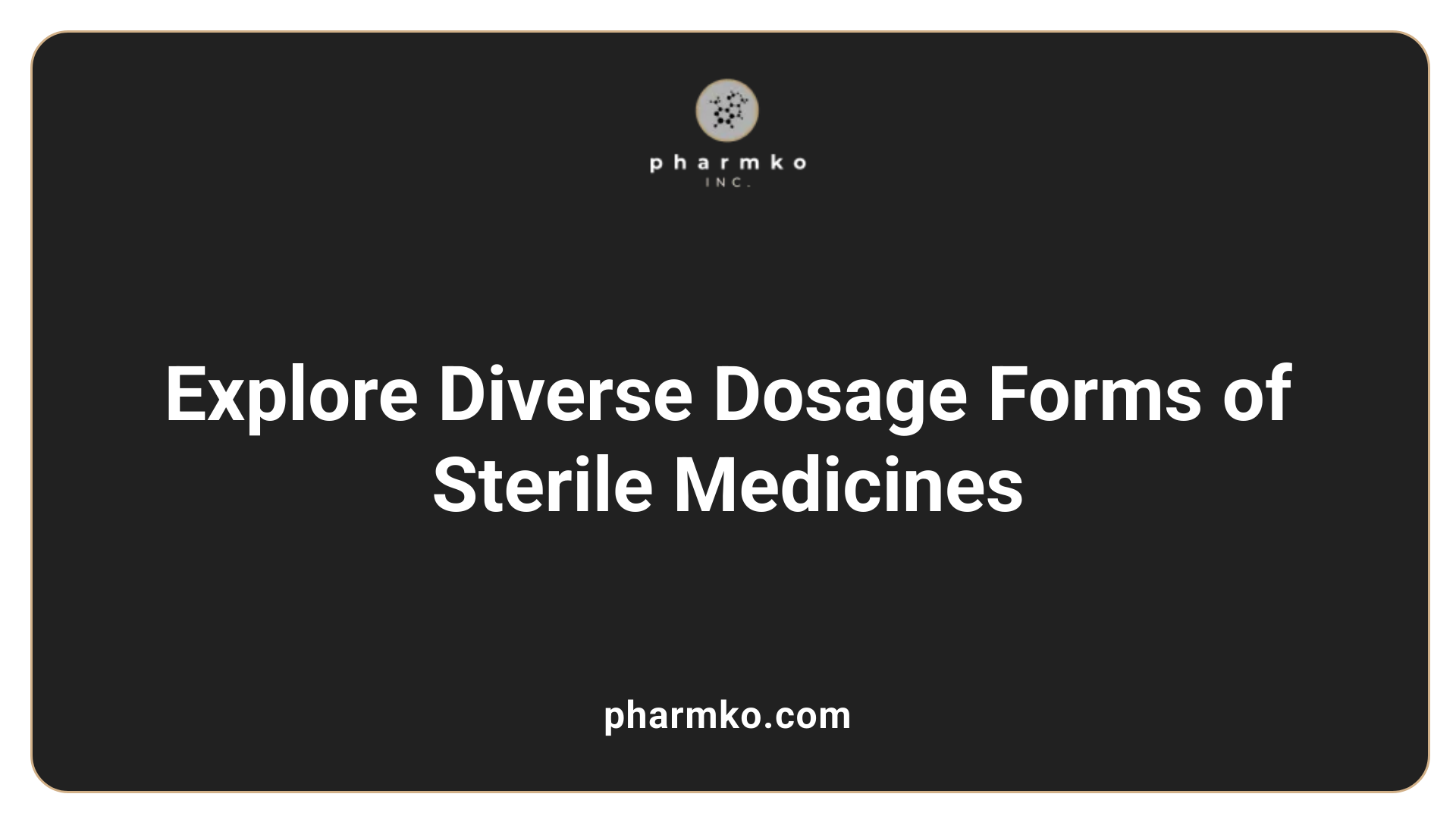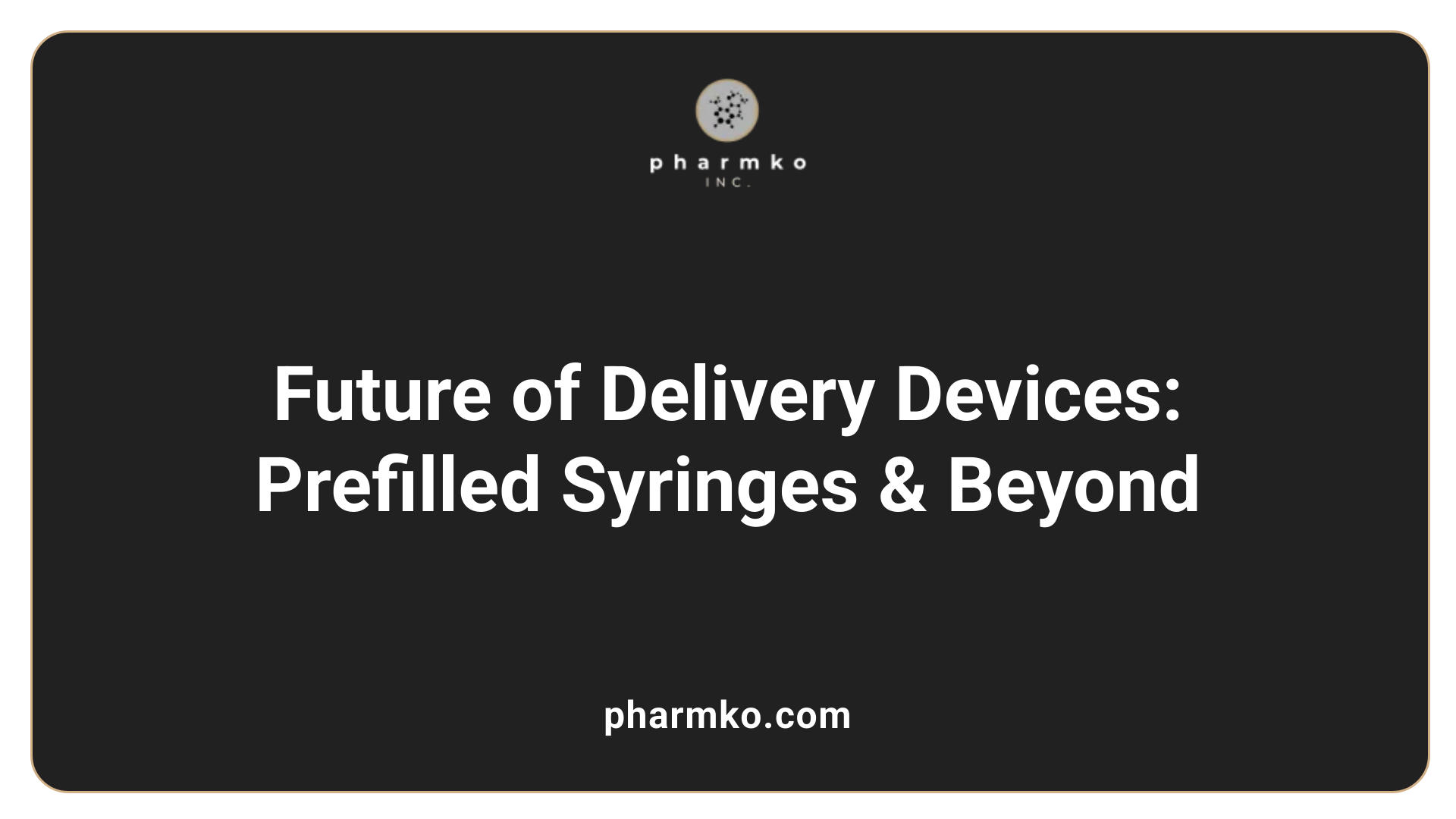What are sterile injectables, and how are they used?
Understanding the Foundations of Sterile Injectables
Sterile injectables are vital components of modern healthcare, designed to deliver medications directly into the body with assurance of safety and efficacy. Their unique manufacturing processes and stringent quality standards distinguish them from other drug forms, enabling rapid onset of action and high bioavailability. This article explores the nature, production, applications, and technological advances that underpin the critical role of sterile injectables in medicine today.
What Are Sterile Injectables and Their Usage in Medicine
What are sterile injectables and how are they used in pharmaceutical applications?
Sterile injectables are medications administered directly into the body via injection, and they must be completely free from any microbial contamination. This strict requirement is crucial because injectables bypass the body's natural defenses, making infections potentially severe or life-threatening.
These drugs are used in a wide range of medical conditions, including cancer treatments, vaccines, diabetes management, and chronic illnesses such as multiple sclerosis and HIV/AIDS. They are delivered through various routes such as intravenous (IV), intramuscular (IM), or subcutaneous (SC) injections, enabling rapid absorption and ensuring complete bioavailability.
Manufacturing sterile injectables involves complex, highly regulated processes designed to prevent contamination. Companies use two main production methods: terminal sterilization, where the final product is sterilized after filling and sealing, and aseptic manufacturing, where each component is sterilized separately, and the product is assembled in a sterile environment. These processes are carried out in specialized cleanrooms with rigorous quality controls.
Quality assurance is critical for sterile injectables. Industry standards set by agencies like the FDA ensure products meet strict safety, purity, and potency criteria. Sterility testing involves various methods, including incubation and media fill tests, to confirm the absence of contamination.
Overall, sterile injectables play a vital role in health care by providing effective, safe treatments for conditions that require immediate or precise drug delivery, backed by advanced manufacturing and quality assurance practices to ensure patient safety.
Types and Common Dosage Forms of Sterile Medicines
 What are examples of sterile medicines, and what are their common dosage forms?
What are examples of sterile medicines, and what are their common dosage forms?
Sterile medicines encompass a wide range of therapeutic products that are administered via injection or infusion, designed to bypass natural defenses and deliver drugs directly into the body. Examples include insulin for diabetes management, cefuroxime injections for bacterial infections, and various other solutions or suspensions used across medical fields.
The most common dosage forms include parenteral preparations such as vials, ampoules, and pre-filled syringes. Vials serve as versatile containers that can be used for multiple doses, while ampoules provide single-dose options that are typically sealed with a glass neck. Prefilled syringes and cartridges are increasingly popular for biologics and biosimilars, offering convenience and reducing dosing errors.
In addition to injections, sterile medicines also include ophthalmic preparations like sterile eye drops and ointments, as well as inhalational products such as aerosols and pulmonary solutions. These formulations require stringent sterility to prevent infections, especially as they are applied to sensitive areas like the eyes or respiratory tract.
Manufacturing methods such as terminal sterilization—using heat, gamma radiation, or gases—and aseptic processing are employed to ensure these products are free from microbial contamination. The choice of dosage form and production method depends on factors like drug stability, route of administration, storage needs, and therapeutic objectives.
Overall, these sterile medicines are critical in treating both acute and chronic conditions, with their respective packaging designed to maintain sterility and ensure patient safety throughout the product’s shelf life.
The Critical Need for Sterility and Standard Practices

Why is sterility important for injectable medicines?
Sterility is essential for injectable medicines because these products are directly introduced into the body, bypassing natural defenses against pathogens. If contaminated, they can cause severe infections such as sepsis, which can be life-threatening. Ensuring that injectable drugs are free from microorganisms protects patient safety and maintains the medication’s efficacy.
The manufacturing of sterile injectables involves complex processes like aseptic processing and terminal sterilization. These methods help eliminate or prevent microbial contamination throughout production. Rigorous sterilization procedures, combined with thorough quality controls—including microbiological testing and validation—are fundamental to guaranteeing product safety.
Regulatory agencies such as the U.S. Food and Drug Administration (FDA) and the European Medicines Agency (EMA) set strict standards to uphold sterility. These guidelines require manufacturers to implement Good Manufacturing Practices (GMP), validate sterilization cycles, and conduct ongoing monitoring. Such measures help prevent contamination, safeguard public health, and ensure the medicines perform as intended.
In summary, maintaining sterility in injectable medicines is not just a regulatory requirement; it is a critical safeguard that protects patients from infection complications, ensures therapeutic effectiveness, and upholds trust in pharmaceutical products.
Manufacturing Techniques for Ensuring Sterility

What are the key steps involved in the manufacturing process of sterile injectables?
Producing sterile injectables requires meticulous processes to prevent contamination and ensure safety. There are two main approaches used in manufacturing: terminal sterilization and aseptic fill-finish.
Terminal sterilization involves sterilizing the final sealed product, usually in its final container. Common sterilization methods include steam autoclaving, gamma radiation, or using gases like ethylene oxide. This method is effective for heat-stable drugs and is generally more cost-efficient.
On the other hand, aseptic manufacturing focuses on maintaining sterility throughout the production process. It involves sterilizing raw materials, vials, syringes, and other components separately before assembling them in controlled environments, such as cleanrooms. This method is essential for biologics and heat-sensitive drugs.
Both processes require rigorous quality controls, including sterilization validation, environmental monitoring, and sterility testing. These measures help prevent microbial contamination and guarantee product sterility.
In addition to sterilization techniques, several other steps are crucial: formulation development, sterile processing, lyophilization for stability, primary packaging, and visual inspection. Each phase is carefully monitored and validated against stringent regulatory standards to ensure the final injectable is safe, effective, and free from viable microorganisms.
Ultimately, maintaining strict sterility throughout manufacturing is vital for patient safety and product efficacy, requiring sophisticated facilities, trained personnel, and comprehensive quality assurance protocols.
Role of Technologies and Industry Standards in Manufacturing
Advancements in sterile injectable manufacturing have significantly enhanced process efficiency, product quality, and regulatory compliance. A major technological leap has been the widespread adoption of single-use systems (SUTs), including disposable bags, filters, and tubing. These systems provide flexibility, prevent cross-contamination, and reduce cleaning requirements, making processes more adaptable and cost-effective.
Automation and robotics have also transformed the industry. Robotic systems, such as gloveless robotic isolators, ensure sterile environments, improve precision during filling, and minimize human error. Technologies like restricted access barrier systems (RABS) further enhance sterility by creating controlled environments that restrict microbial entry.
Innovative aseptic processing methods—like isolator technology—provide consistent sterile conditions, crucial for sensitive biologics and complex drugs. Moreover, the implementation of Process Analytical Technology (PAT) allows real-time monitoring of critical process parameters, enabling immediate adjustments to maintain product quality. The Quality by Design (QbD) framework guides process development with a focus on understanding variability and ensuring robust manufacturing.
Emerging platforms such as ApiJect incorporate Blow-Fill-Seal (BFS) technology, coupled with smart temperature control and advanced particulate inspection systems. These innovations streamline sterile fill/finish operations, improve product safety, and address modern production challenges efficiently.
Overall, these technological advancements, coupled with stringent industry standards, are shaping the future of sterile injectable manufacturing, ensuring higher safety, quality, and supply reliability across global markets.
Shifting Formats and Future Trends in Delivery Devices

Prefilled syringes and ease of use
Prefilled syringes have become a preferred delivery device for many sterile injectables due to their enhanced safety profile and user-friendly design. They reduce dosing errors, simplify administration, and improve patient adherence, especially for biologic therapies and biosimilars. The convenience of prefilled syringes makes them ideal for self-injection, at-home treatments, and quick clinical responses.
Transitioning from traditional glass vials to prefilled syringes involves addressing technical and regulatory hurdles. Manufacturers must ensure that the finishes provide stable drug stability, proper sealing, and compatibility with delivery devices. These formats also reduce drug waste caused by overfilling, supporting cost efficiencies and minimizing product losses.
Market growth and demand drivers
The market for sterile injectable delivery devices, particularly prefilled syringes, is experiencing rapid growth. This trend is fueled by the increasing prevalence of chronic diseases like diabetes, rheumatoid arthritis, and other autoimmune conditions.
Advancements in biologics and biosimilars, which often require precise dosing and ease of administration, propel demand for prefilled formats. The shift supports the rise of outpatient treatments and home-based therapies, providing greater convenience for patients.
Furthermore, regulatory initiatives prioritizing patient safety and compliance emphasize the need for reliable, contamination-free delivery systems. The market is projected to surpass reach USD 762 billion by 2028, indicating strong future growth.
Transition challenges and regulatory considerations
Transitioning to new formats involves significant challenges. Manufacturing facilities must adopt advanced fill-finish technologies, such as robotic aseptic platforms, to maintain high sterility standards. Technologies like Cytiva Microcell and SA25 have been adopted to support scalable, flexible, and high-precision sterile filling across various container types, including vials, syringes, and cartridges.
Regulatory compliance is critical. Companies need to validate new processes through rigorous testing, including sterility assurance, stability, and extractables/leachables assessments. Achieving approval involves extensive documentation and adherence to Good Manufacturing Practice (GMP) standards from authorities like the FDA and EMA.
Moreover, supply chain adjustments are necessary to accommodate different device specifications and storage requirements. Despite these hurdles, the benefits—such as enhanced safety, convenience, and potential for extended product lifecycle—make the transition a strategic priority for pharmaceutical companies.
Technologies supporting new delivery formats in sterile injectables
Technologies like robotic aseptic platforms utilizing systems such as Cytiva Microcell and SA25 provide scalable, flexible, and high-precision sterile filling capabilities for a variety of dosage forms, including vials, syringes, and cartridges. These systems ensure high sterility and fill accuracy, reducing product loss, and supporting complex biologics and high-value drug production.
The use of prefilled syringes, in particular, enhances patient safety by reducing dosing errors and simplifying medication administration. This shift is driven by increasing demands for self-administration, improved convenience, and adherence to regulatory standards emphasizing safety and usability.
Transitioning between traditional formats like glass vials to prefilled syringes involves rigorous testing, validation, and compliance with global regulations, often requiring significant logistical and manufacturing adjustments.
Impact of Industry Growth and Challenges

What is the current market outlook and future trends for sterile injectables?
The market for sterile injectables is expanding rapidly, reflecting the growing demand for complex, small-volume medications that require utmost purity and safety. By 2028, experts project this market will reach approximately USD 762.48 billion, a significant increase from USD 52.88 billion in 2023.
This surge is driven by an aging global population, the rise of chronic illnesses, and advancements in biologics, including monoclonal antibodies and cell therapies. The expansion of healthcare access worldwide has fueled demand for innovative treatments delivered through sterile injectables.
In response, industry players are heavily investing in increasing manufacturing capacities, adopting cutting-edge technologies, and strengthening compliance with regulatory standards such as those from the FDA and WHO. These efforts ensure stability in supply while maintaining product safety and quality.
Supply chain and capacity issues
As demand surges, the sterile injectable sector faces notable challenges in supply chain management. Capacity constraints can lead to drug shortages, affecting patient care and treatment outcomes.
Manufacturers are working to scale up their operations, often through acquisitions and the construction of new facilities equipped with automation and advanced sterilization technologies. Maintaining a steady supply chain requires precise coordination of raw materials, sterile processing, and packaging, all while adhering to strict regulatory guidelines.
Maintaining quality and compliance
Ensuring consistent quality amidst expanding production is paramount. This involves rigorous validation of sterilization cycles, deployment of real-time process monitoring, and detailed traceability systems like serialization and blockchain.
Innovation in automation reduces human error, while high-performance analytical techniques (e.g., HPLC, MS) verify purity and potency. Regular audits and adherence to good manufacturing practices (GMP) are critical to meet evolving standards.
Overall, the industry’s future hinges on balancing rapid growth with uncompromising quality, leveraging technological advancements, and navigating logistical challenges.
Conclusion: The Critical Role of Sterile Injectables in Healthcare
Sterile injectables are vital components of modern healthcare due to their ability to deliver medicines directly into the body with rapid and complete bioavailability. They are essential for treating critical conditions such as cancer, infections, and chronic illnesses, where timely and effective medication delivery can be life-saving.
Regulatory agencies like the FDA and WHO strictly oversee their production, emphasizing high standards of sterility, quality, and safety. Manufacturing involves complex processes such as aseptic filling, terminal sterilization, and lyophilization, all designed to minimize contamination risks. Advances in technology, including automation and robotics, continue to enhance safety and efficiency, supporting the growing demand for biologics and advanced therapeutics.
The evolution of delivery formats, like prefilled syringes, improves patient convenience and reduces errors, reflecting ongoing innovations in the sector. The expanding market, driven by aging populations and rising chronic diseases, underscores the importance of maintaining regulatory standards and pursuing technological advancements to meet future healthcare needs.
Overall, sterile injectables are crucial for ensuring safe, effective, and rapid treatment options, playing an indispensable role in improving health outcomes globally.
The Future of Sterile Injectables in Medicine
Sterile injectables are a cornerstone of effective healthcare, underpinning critical therapies across a range of diseases. Their manufacturing involves highly complex, regulated processes designed to guarantee sterility and safety. Advances in technology, strict regulatory standards, and changing delivery formats like prefilled syringes continue to shape the industry, making treatments more accessible, safer, and more efficient. As global demand grows, ongoing innovation and adherence to quality standards are essential to meet patient needs and ensure optimal health outcomes. The evolution of sterile injectables will undoubtedly play a pivotal role in the future of medical treatment, maintaining its vital place in both therapeutic and preventative medicine.
References
- Sterile Injectable Drugs Defined - Ascendia Pharmaceutical Solutions
- What is a Sterile Injectable and How Are They Made? - ten23 health
- Understanding the Production Process of Sterile Injectables
- Our Work in Developing Sterile Injectables - Oakwood Labs
- Sterile injectable therapies: Changing delivery formats ... - Patheon
- Sterile Injectable CDMOs: A Comprehensive Guide to Trends and ...
- Sterile Injectables CMOs: The Empowering Impact of Technology on ...
- Grasping the Process of Sterile Injectables Manufacturing













